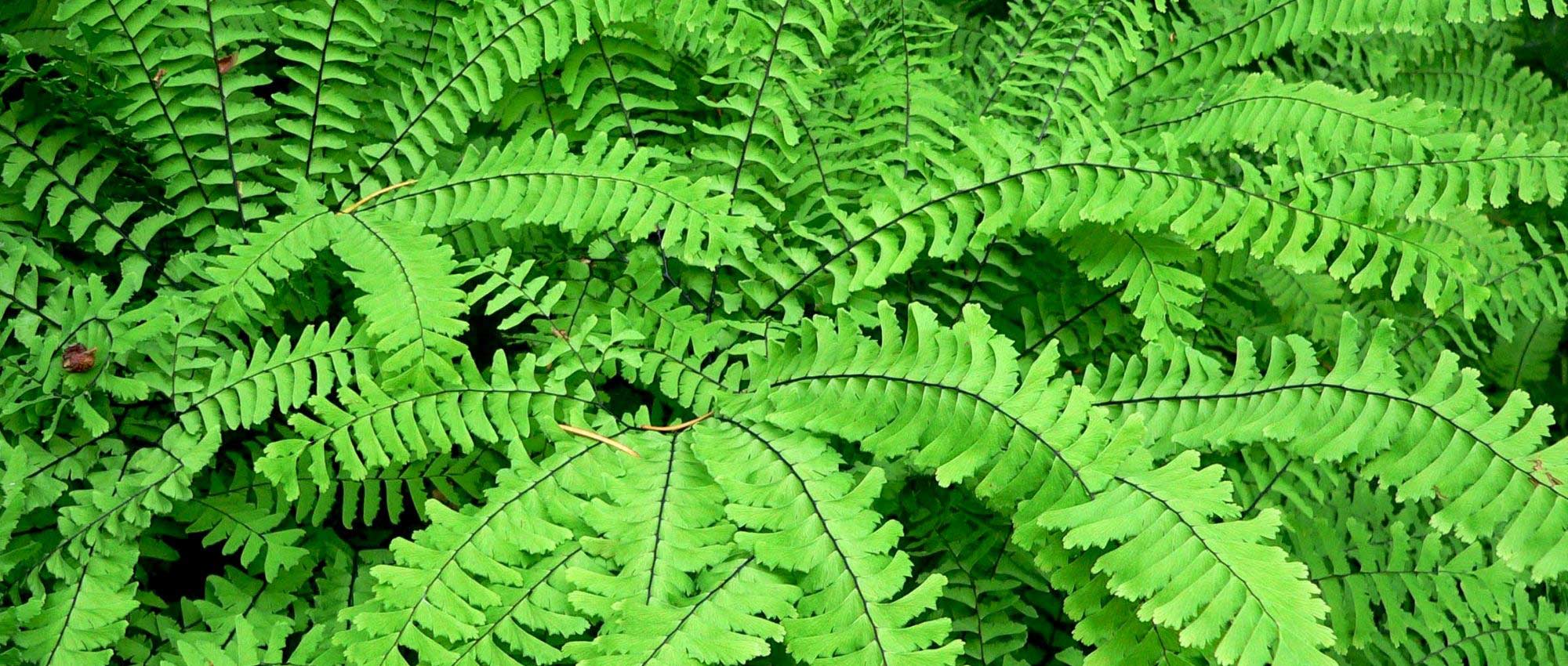
The Capillary or Adiantum: planting, cultivation, and care
Contents
Adiantum in a nutshell
- The Capillary is a fern appreciated for its very light foliage!
- It has a beautiful soft green colour, enhanced by black petioles and rachis.
- It thrives in shade, in cool, humus-bearing soil.
- The Adiantum pedatum and Adiantum aleuticum ‘Imbricatum’ are quite hardy!
- They are perfect for a woodland garden, a shaded rockery, or an Asian-style garden.
A word from our Expert
The fern Capillary or Adiantum is a stunning plant with incredibly light foliage! The most well-known species is Adiantum capillus-veneris, a beautiful plant typically grown indoors, commonly referred to as Venus Hair or Montpellier Capillary. However, there are also some hardy Adiantum that easily find their place in the garden. This includes Adiantum pedatum and Adiantum aleuticum ‘Imbricatum’, which can withstand temperatures as low as -15 °C.
Adiantum are ferns that are still too rarely cultivated in gardens. Yet, they are perfect for creating a fresh and verdant atmosphere. In the garden, Adiantum thrive in shade, in cool, humus-rich soil. They can be planted in a woodland garden or in a cool, shaded rockery. They require little maintenance, other than ensuring the soil remains relatively cool, and they will appreciate organic mulching. They pair well with other woodland plants, such as hostas, polygonatums, sweet woodruff, or brunneras.
Botany
Botanical data
- Latin name Adiantum sp.
- Family Pteridaceae
- Common name Capillary
- Flowering none
- Height up to 60 cm
- Exposure shade or partial shade
- Soil type cool, rich, humus-bearing
- Hardiness -15 °C
Capillaries or Adiantum are splendid ferns, remarkable for their fine and light foliage. They belong to the large group of Pteridophyta, which includes ferns, horsetails, and selaginellas. They are truly unique plants within the vegetable kingdom. Life was originally aquatic, with the plants that existed then being algae, and ferns were among the first plants to emerge from the water, around 400 million years ago, to conquer the land. They were present long before plants invented flowers and seeds for reproduction! However, ferns still retain a dependency on water today, which they need for reproduction, which is why most grow in cool or moist soils.
There are between 170 and 200 species of Adiantum, but only a few species are cultivated in gardens or indoors. In the wild, most Capillaries are found in South America. There are also many species native to Asia, particularly China. The Adiantum pedatum originates from North America (Canada, United States) and Southeast Asia.
Adiantum belong to the family Pteridaceae, which mainly includes rhizomatous ferns, most of which are native to tropical regions. These plants can be terrestrial, lithophytes (growing on rocks), or epiphytes (growing on other plants).
For Adiantum, as with all ferns, a specific vocabulary is used: we do not refer to leaves, but to fronds. These are divided into small segments called pinnules. The black axes bearing the pinnules are known as the rachis.
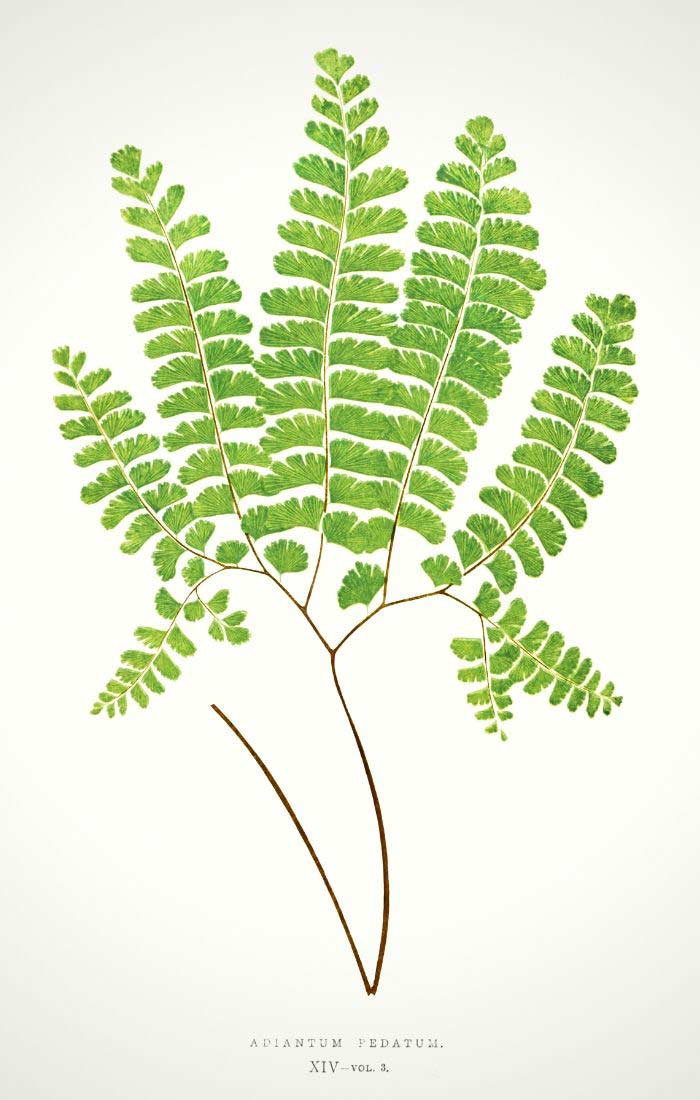
Adiantum pedatum: botanical illustration
Some Adiantum are quite hardy and can be easily grown outdoors: Adiantum pedatum, Adiantum aleuticum ‘Imbricatum’ and Adiantum venustum can withstand temperatures down to -15 °C. Their foliage may be damaged by the cold, but the stump usually regrows without issue in spring. The Adiantum capillus-veneris is more delicate: it is often grown as an indoor plant, but it tolerates temperatures between -6 and -10 °C.
The genus name Adiantum comes from the Greek adiantos, meaning “not wet,” as the pinnules quickly shed water, allowing it to run off their surface. Adiantum are also known as Capillaries, alluding to the fineness of their foliage! Indeed, their black and slender rachis resembles hair. The Adiantum capillus-veneris is even nicknamed “Venus’s Hair”! As for the Adiantum pedatum, its species name means “pedate,” referring to the composition of the fronds, which are almost palmate but with lateral pinnae joined at the base. A similar pedate foliage can also be found in hellebores.
Adiantum grow in fairly dense and spreading clumps. They form upright black petioles that emerge from the ground, originating from a creeping rhizome, and bear horizontal fronds. Their short and running rhizome allows them to spread, and when they thrive, they can eventually form large colonies, but Adiantum grow slowly and do not become invasive. The Adiantum pedatum reaches a maximum height of 50 to 60 cm, while the Adiantum aleuticum ‘Imbricatum’ is smaller and more compact, not exceeding 30 cm in height.
In spring, when the capillary fern begins its growth, it produces red croziers that unfurl into fronds with shades of pink-orange. They then take on a light green hue.
In other fern species (for example, Dryopteris, Athyrium, Matteuccia…), the fronds are often pinnate and regular, shaped like feathers or triangles, but this is not the case for Adiantum. The latter have much more original and seemingly less structured forms, appearing freer. The pedate fronds of the Adiantum pedatum take on a fan shape. In Adiantum, the fronds are often arranged horizontally or drooping towards the ground, rather than being upright.
The fronds consist of pinnules that have a broad and slightly dentate shape at the top. They display a beautiful light green – glossy colour, enhanced by the dark hue of the rachis. They bring brightness to the understory.

Entire frond and detail of the pinnules of Adiantum pedatum (photos Walter Siegmund and David J. Stang). The very light and airy fronds of Adiantum capillus-veneris
The petioles and rachis are particularly slender and dark in colour, giving the plant a lot of lightness: the pinnules appear to be “suspended,” supported by barely visible axes. This creates the very airy appearance that is so appreciated in Adiantum!
Adiantum pedatum is deciduous to semi-evergreen, depending on the climate. It can retain its leaves in winter in regions with particularly mild climates.
Adiantum, like other ferns, do not produce flowers or seeds. They are primitive plants that date back to a time when plants had simply not yet invented these means of reproduction. Instead, Adiantum produce spores: these are microscopic organs resembling dust. The spores are enclosed in small “sacs” called sporangia, which open when mature. These sporangia are themselves gathered in clusters called sori.
In Adiantum, the sori are located on the underside of the fronds and gathered at the edge of the lamina. They are covered by a false indusium (= membrane protecting the sporangia), made up of a leaf segment. It is possible to collect the spores when they are mature, in order to sow them. The arrangement of the sori, and the presence or absence of indusia as well as their shape, are important criteria for identifying ferns.
When mature, the spores are carried away by the wind and then settle on the ground. They germinate in the presence of moisture and give rise to a small intermediate organism: the prothallus. This will produce male or female gametes, which can come into contact through water, and then produce a new fern in the form we know. Adiantum are therefore dependent on water for their sexual reproduction.

The sori on the underside of the fronds of Adiantum cunninghamii and Adiantum raddianum (photo Forest and Kim Starr)
Read also
Planting fernsThe main varieties of Adiantum
The Most Popular Varieties
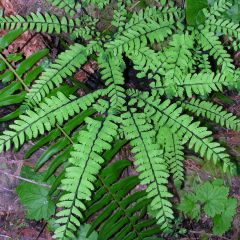
Adiantum pedatum
- Height at maturity 60 cm
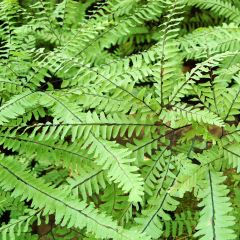
Adiantum aleuticum Imbricatum
- Height at maturity 30 cm
Our Favourites
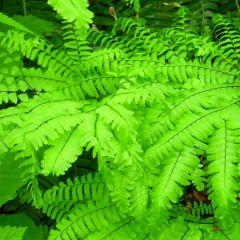
Adiantum aleuticum Miss Sharples
- Height at maturity 30 cm
Discover other Adiantum
View all →Available in 1 sizes
Available in 1 sizes
Available in 1 sizes
Available in 1 sizes
Available in 1 sizes
Available in 1 sizes
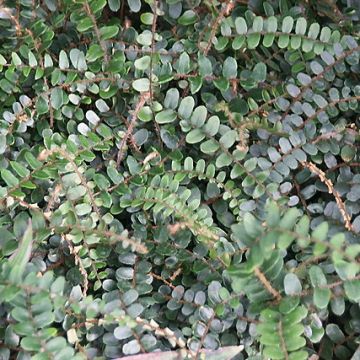
Available in 1 sizes
Available in 1 sizes
Planting of the Capillary
Where to plant?
As the Capillary is a plant that naturally grows in undergrowth, it requires a shaded or semi-shaded location. Direct sunlight could dry it out and scorch its foliage! Ideally, it should be placed in conditions similar to its natural habitat. It thrives in soil like that found in forests: fertile, light, and humus-bearing. Don’t hesitate to add compost or leaf mould to enrich the soil. Like other ferns, Adiantum prefers soils that remain cool, but it should still be relatively well-draining. We also recommend choosing a sheltered spot from the wind.
You can also place Adiantum in a cool, shaded rockery. This will showcase it beautifully, but be mindful to keep the soil consistently cool; it must never dry out completely!
Be sure to choose its location carefully from the start: Adiantum takes a long time to settle in and does not appreciate being transplanted.
When to plant?
You can plant Adiantum in autumn or spring. The most important thing is to avoid periods of frost or extreme heat.
How to plant?
- Place the root ball in a basin of water to rehydrate it. This will aid in its establishment.
- Dig a planting hole two to three times the size of the root ball.
- Replace some of the leaf mould in the hole, mixing it with your garden soil to enrich the soil.
- Remove the fern from its pot and plant it, ensuring that the top of the root ball is level with the soil.
- Replace the soil around it and lightly firm it down.
- Water generously.
- You can then apply organic mulch around the plant to keep the soil cool.
For more explanations and tips, discover our advice sheet: Planting ferns.
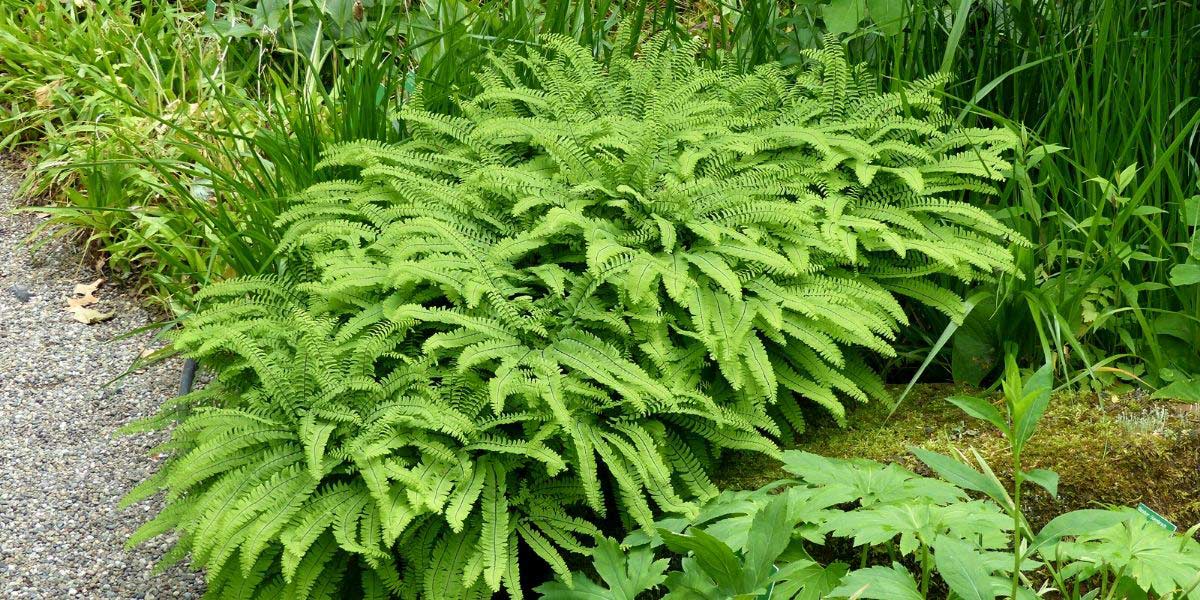
Entretien
Remember to carry out regular watering in the weeks following planting, and ensure that the soil remains relatively moist. Be vigilant during dry periods and do not hesitate to water if necessary.
We recommend installing organic mulch around your Adiantum. This will help keep the soil cool for longer and limit the growth of weeds. Additionally, as it decomposes, it will enrich the soil and promote the activity of soil microorganisms. For example, you can use fallen leaves, RCW (ramial chipped wood), flax mulch, or bark, applying it in several centimetres of thickness.
You can also add well-decomposed compost once a year to enrich the soil.
In autumn, you may consider placing a layer of fallen leaves over the stump to protect it from the cold.
Clean the clump at the end of winter – beginning of spring by removing the fronds that have dried. Throughout the year, we also advise cutting any damaged fronds as you notice them.
The Capillary grows slowly, especially in the first two years. It does not appreciate being transplanted.
Like other ferns, Adiantum is not very susceptible to diseases and pests. However, it can occasionally happen that slugs nibble on the young fronds.
Multiplication
To multiply Adiantum, we recommend clump division, as this technique is easier and quicker than sowing spores.
Clump Division
As Adiantum forms short, running rootstocks, it is possible to divide the clumps, preferably in spring.
- Choose a well-developed clump that has been in place for several years.
- Gently take a section of rootstock with a few fronds and roots.
- Replant immediately in another location after preparing the soil.
- Water generously.
- Continue to water in the following weeks to keep the soil moist until it establishes.
Sowing Spores
Sowing spores is done in spring. First, collect spores from the underside of Adiantum fronds. When they are mature, they turn brown and detach easily from the fronds. This is a delicate and time-consuming technique, but unlike division, it allows you to keep your existing Adiantum clumps intact in the garden. It’s a good solution if your Adiantum are still too small to be divided.
- Prepare a seed tray or container with potting soil that you will moisten. It is advisable to sterilise the substrate by microwaving it for 10 minutes: this precaution will prevent the development of mosses or fungi.
- Lightly compact the substrate.
- Sprinkle the spores on the surface, but do not cover them!
- Place a transparent lid on the seed tray or container to keep the medium moist and sterile.
- Position the tray in a bright location, out of direct sunlight.
- Ensure the substrate remains moist. If it dries out, do not hesitate to water, preferably using a spray bottle.
For more information and advice, discover our sheet to learn how to sow fern spores?
Association
Adiantum is ideal for a cool, shaded woodland garden. You can pair it with other plants that thrive in similar growing conditions. We particularly recommend choosing plants with generous, opulent foliage, such as hostas, polygonatum, or brunneras to create a lovely contrast of shapes. Also, enjoy the delicate flowering of Tricyrtis! Integrate Epimediums, Geranium nodosum, astrances, and sweet woodruff…
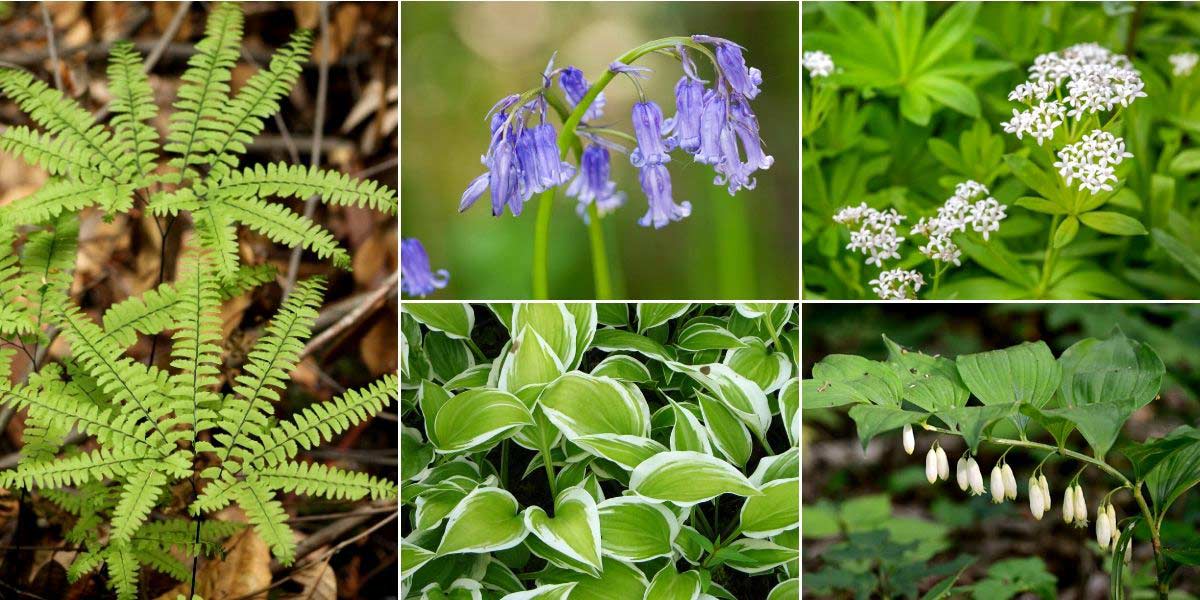
Adiantum are perfect for accompanying other woodland plants, creating a very natural garden style! Adiantum aleuticum (photo Edward Rooks), Wood hyacinth (photo Olivier Pichard), sweet woodruff, Hosta ‘Emily Dickinson’, and Polygonatum latifolium (photo Radio Tonreg)
Adiantum pairs wonderfully with other varieties of ferns: Coniogramme emeiensis, Dryopteris, Athyrium, Polypodium, Matteuccia… Together, they will create a fresh, lush, and very natural atmosphere. Plant them near a pond or stream, for example.
You can welcome Adiantum in a cool, shaded rockery. Create a raised bed in the woodland, preferably near a water source (fountain, stream…), and place some large stones chosen for their aesthetic appeal and to hold the soil. Then, create pockets of substrate between the stones to plant Adiantum and other shade plants. For companions, consider saxifrages, Hakonechloa, Carex morrowii, corydalis, Tiarella, or heucheras.
This stunning fern will also find its place in an Asian, zen-style garden. Pair it with dwarf bamboos, Japanese anemones, Hakonechloa macra, Coniogramme emeiensis, Ophiopogon, Asian primroses… Also consider small ground-cover plants, such as Sagina subulata or Helxine. They will form a green, uniform carpet resembling moss. You will achieve a beautiful, minimalist garden, conducive to meditation and ideal for recharging.
If you would like more ideas and inspiration, discover our advice sheet Ferns: 9 easy association ideas to succeed!
Useful resources
- Discover our range of Adiantum
- To accompany Adiantum, discover our entire range of ferns
- Our advice sheet Planting Ferns
- Our advice sheet How to Sow Fern Spores?
- For more ideas on pairing Adiantum in the garden, check out our sheet Ferns: 9 Easy Association Ideas to Succeed!
- The site Fernatic, with plenty of information on ferns and their cultivation
- Subscribe!
- Contents
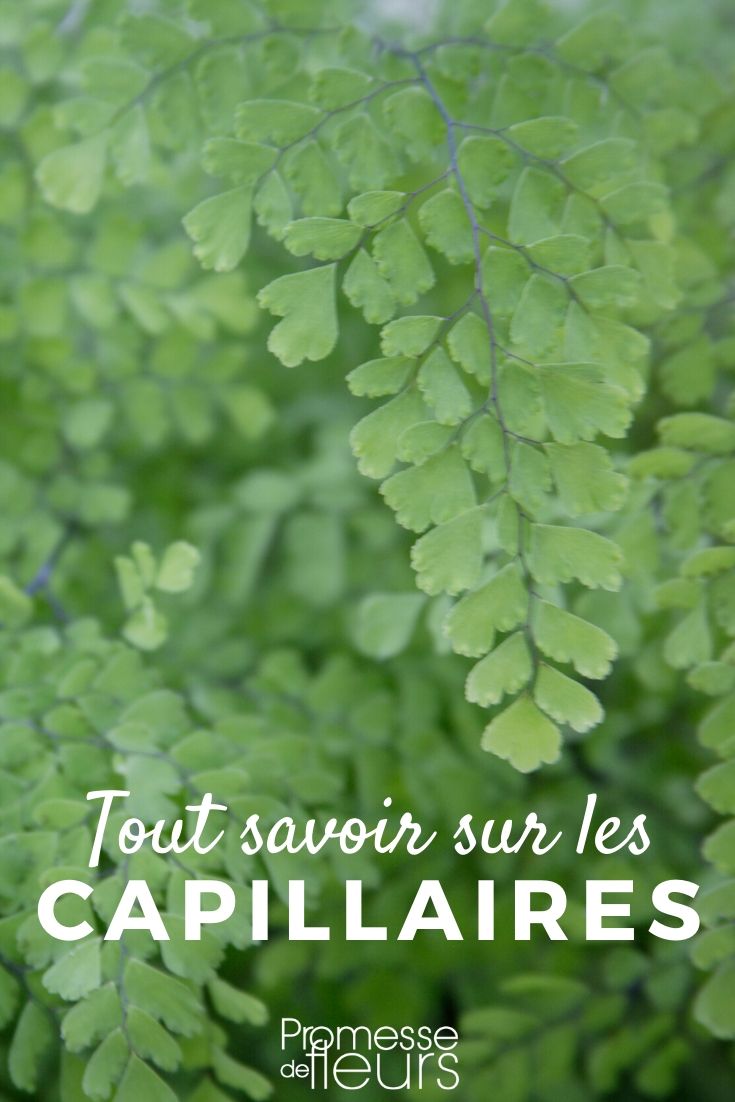
































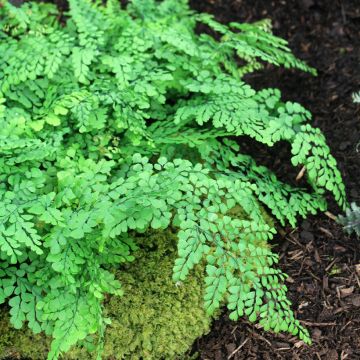

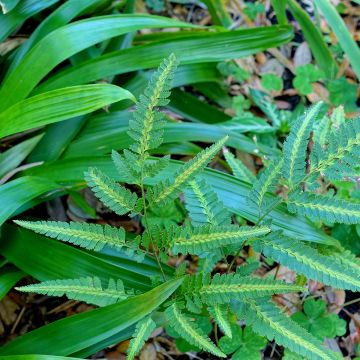
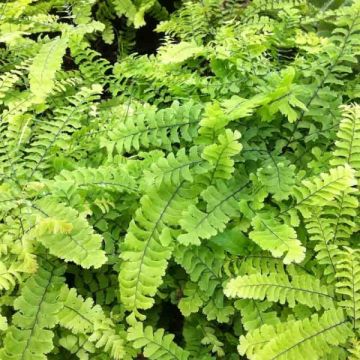
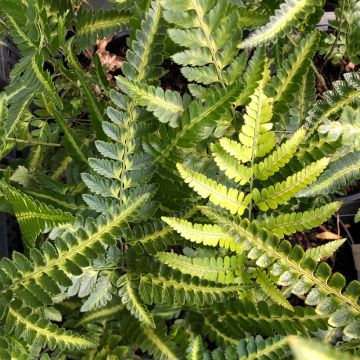

Comments